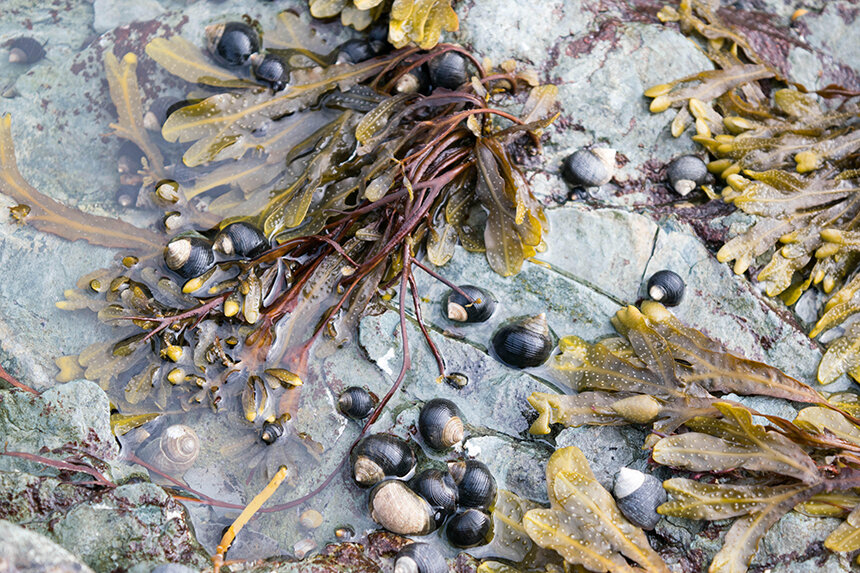By GRACE KELLY/ecoRI
News staff


Periwinkles that are
harvested locally are typically exported to Asia. (Kate Masury/Eating with the
Ecosystem)
Why go to France for fancy escargot when the abundant local periwinkle beckons?
These common seaside snails are an
invasive species originally from Europe. They spend their days on briny rocks
eating barnacle larvae and algae.
While what few periwinkles that are harvested are typically exported to Asia, you may find them at local Asian or Portuguese markets, or you can head to any rocky beach and you can “pick-your-own” periwinkles.
While what few periwinkles that are harvested are typically exported to Asia, you may find them at local Asian or Portuguese markets, or you can head to any rocky beach and you can “pick-your-own” periwinkles.
“I think they are really tasty. They
have a sweet, briny flavor I would compare to a steamer clam,” Kate Masury of Eating with the Ecosystem said.
Because of their small size, she
suggested using them as a locally sourced hors d’oeuvre.
“You won’t typically fill up on
periwinkles, but they make an excellent appetizer or snack, and can add a nice
flavor to other seafood dishes such as seafood stews and sauces,” she said.
While a more traditional preparation
is given below, Masury mentions a unique interpretation that is also worth
trying.
“At one of our dinners in 2017, chef
Chris Kleyla from the Statesman Tavern in Bristol prepared them by marinating
them and serving them on toast. It was absolutely delicious.”
Featured species: periwinkle
Flavor: salty, sweet
Texture: delicate, soft, creamy
Sustainability level: These little snails aren’t commonly consumed, so have at it.
What to look for: If buying from a store, look for a market with circulating water tanks, since this means they have lots of turn over and less chance of purchasing dead periwinkles.
When you’re sorting through your haul, smell can give away a dead periwinkle, as can a poke to their operculum, the hatch that closes the shell.
If they respond to a poke with a toothpick, they are alive. If they’re dead, the operculum is usually pulled up inside the shell. Discard dead periwinkles.
Serves 4
- 2 lbs periwinkles, scrubbed and rinsed
- 1 cup white wine
- 2 tbsp finely chopped garlic (Tip: use a microplane)
- 7 sprigs fresh thyme
- 2 tbsp fresh parsley, separated into stalks and leaves
- ½ pound butter, cut into cubes
- Salt to taste
- 1 lemon, cut into quarters
Place a large saucepan over high
heat on the stove. Mix periwinkles, wine, garlic, thyme, and parsley stalks in
a bowl.
Once the saucepan is extremely hot, add ingredients and cover. Steam for 2-3 minutes.
Remove periwinkles using a slotted spoon and set aside.
Lower heat to medium and reduce liquid to ¼ cup, Strain into a saucepan. Over extremely low heat, whisk in butter, a few cubes at a time, until emulsified.
Finely chop parsley leaves and add to the saucepan. Season with salt.
Place periwinkles in a shallow serving bowl. Pour butter sauce over periwinkles and serve with lemon wedges and crusty bread. Use a toothpick to scoop out the flesh from the shells.
Once the saucepan is extremely hot, add ingredients and cover. Steam for 2-3 minutes.
Remove periwinkles using a slotted spoon and set aside.
Lower heat to medium and reduce liquid to ¼ cup, Strain into a saucepan. Over extremely low heat, whisk in butter, a few cubes at a time, until emulsified.
Finely chop parsley leaves and add to the saucepan. Season with salt.
Place periwinkles in a shallow serving bowl. Pour butter sauce over periwinkles and serve with lemon wedges and crusty bread. Use a toothpick to scoop out the flesh from the shells.
You can also make this recipe with
clams, littlenecks, whelks, shrimp, mussels, and lobster.
If you make this dish, don’t forget
to snap a pic and tag us @ecori and @eatingwiththeecosystem on Instagram.